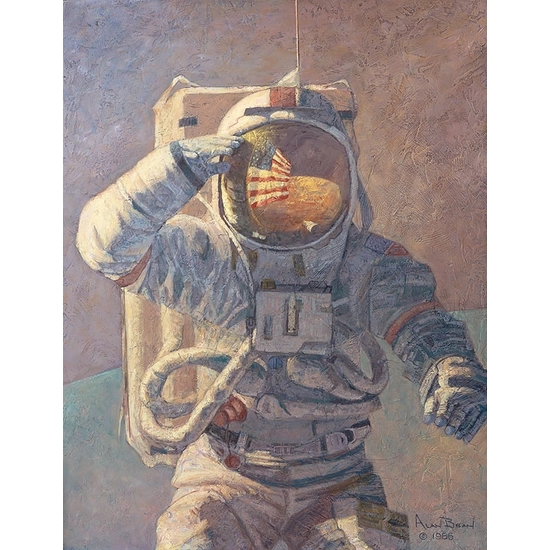Alan Bean Our Own Personal Spaceships Lithograph
Status: Out Of Stock | Condition: New | Edition:Limited Edition Lithograph | Edition Size: Limited Edition of 100 | Dim:16 x 21 | Alan Bean| Item #: AB00085lgp
Price: $ 0.00 USD..
No availability at this time. Be First to be notified once we have Alan Bean - Our Own Personal Spaceships in-stock
Countries We Ship To:
Alan Bean, a former Apollo 12 astronaut, transformed his firsthand experience of space exploration into stunning fine art paintings. As the only artist to have walked on the Moon, his work captures the textured surface of the lunar landscape, often embedding real moon dust and mission patches into his canvases. His impressionistic space paintings bring the Apollo era to life, showcasing astronaut moonwalks, celestial landscapes, and cosmic exploration from a perspective no other artist can provide. His limited edition space prints and original paintings remain highly sought after by collectors of space history art, making Alan Bean a pioneer in astronaut-inspired fine art.
Our Own Personal Spaceships - AB00085lgp
NOTES: Our Own Personal Spaceships - "Every human who walked on the moon did so in his own personal spaceship," says Alan Bean. "We called them space suits and they performed beautifully on all six lunar landings. I painted astronaut John Young all bundled up in his. John commented, ""I can"t speak too highly for the pressure suit. Boy that thing really takes a beating." "The suit is airtight but it would be limp and useless without the connecting hoses reaching around from the backpack we called the PLSS, the Portable Life Support System. Through one hose flows fresh life-sustaining oxygen while another removes the used atmosphere and maintains the suit pressure just above 3.5 pounds per square inch. Another hose circulates water through the small tubes in John"s underwear to carry away excess body heat. Radio communication is provided by another. "Many of the more important functions are monitored and controlled by the RCU, the Remote Control Unit resting squarely on the chest. Finally, a special hose is connected to the suit to give auxiliary oxygen flow in the event the primary oxygen supply were to fail or the suit were punctured and began to leak. John later observed, "ï`since it is the only thing between you and that vacuum in plus or minus 250 degrees, it"s a good piece of gear." Our space suits were an incredible American technical achievement. They had to reliably provide all the functions of any spaceship with one small exception""they contained no rocket engine so we had to utilize our own two legs for propulsion." Now you can own a unique and beautiful piece of lunar history. Alan Bean"s Our Own Personal Spaceships, is painted by the first and only artist to visit another world. Each canvas is signed by the legendary Apollo 12 astronaut, moonwalker and artist. Each is a work of art, each a historic document, each your own personal connection to traveling in space. Own a Fine Art Edition Canvas by astronaut and explorer Alan Bean and you will never look at the Moon the same way again..
Our Own Personal Spaceships Lithograph by Alan Bean is signed by the artist and comes with a certificate of authenticity.
image Copyright © 2025 by Alan Bean

Gift Card Purchase
E-Gift Cards from The Collection Shop are the perfect way to gift art enthusiasts. Click below for more details!
Alan Bean bio
Captain Alan Bean was the lunar module pilot on Apollo 12, the fourth man to walk on the moon and commander of Skylab 2. "I am fortunate enough to have seen sights no other artist ever has," Bean says.
"I want my paintings to communicate an emotional experience in ways that photography cannot."
Captain Bean creates his original works of art using a unique technique allowing the viewer to actually sense vestiges of the 20th century s most dramatic accomplishments. Pressed into the canvas surfaces are Captain Bean s authentic lunar boot "moonprints," impressions from a core tube-bit used to collect soil samples and marks from a hammer used to drive the staff of the American flag into the moon s surface. Moon dust, trapped on the patches on the outside of his suit, makes its way onto each original as well.
Each print and canvas is an historical record of the lunar experience, as each is signed by moonwalker Captain Alan Bean, with most countersigned by other moonwalkers and astronauts.This may be your only chance to own such a visionary and historic celebration of man s greatest achievement. NASA was sometimes asked "Why not send an artist to the moon?" It turns out they did.
Alan Bean—Apollo XII astronaut, commander of Skylab II and artist—was born in 1932 in Wheeler, Texas. In 1950 he was selected for an NROTC scholarship at the University of Texas at Austin. In 1955, he was commissioned an ensign in the United States Navy.
Holder of eleven world records in space and astronautics, as well as numerous national and international honors, Alan Bean has had a most distinguished peacetime career. His awards include two NASA Distinguished Service Medals, the Yuri Gagarin Gold Medal and the Robert J. Collier Trophy. As part of the Apollo XII crew, he became the fourth of only twelve men ever to walk on the Moon. As the spacecraft commander of Skylab Mission II, he set a world record: 24,400,000 miles traveled during the 59-day flight. He has also launched himself successfully into a new career as an artist.
When he wasn t flying, Bean always enjoyed painting as a hobby. Attending night classes at St. Mary s College in Maryland in 1962, Alan experimented with landscapes. During training and between missions as a test pilot and astronaut, he continued private art lessons. On space voyages, his artist s eye and talent enabled him to document impressions of the Moon and space to be preserved later on canvas. His art reflects the attention to detail of the aeronautical engineer, the respect for the unknown of the astronaut and the unabashed appreciation of a skilled painter.
The space program has seen unprecedented achievements and Bean realized that most of those who participated actively in this adventure would be gone in forty years. He knew that if any credible artistic impressions were to remain for future generations, he must paint them now. "My decision to resign from NASA in 1981 was based on the fact that I am fortunate enough to have seen sights no other artist ever has," Bean said, "and I hope to communicate these experiences through art."
Bean s book Apollo: An Eyewitness Account which chronicles his first-person experience as an Apollo astronaut in words and paintings was received with critical and popular acclaim upon its publication in 1998.


